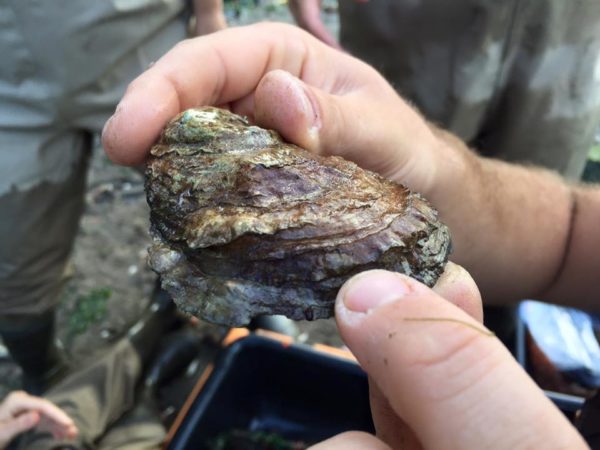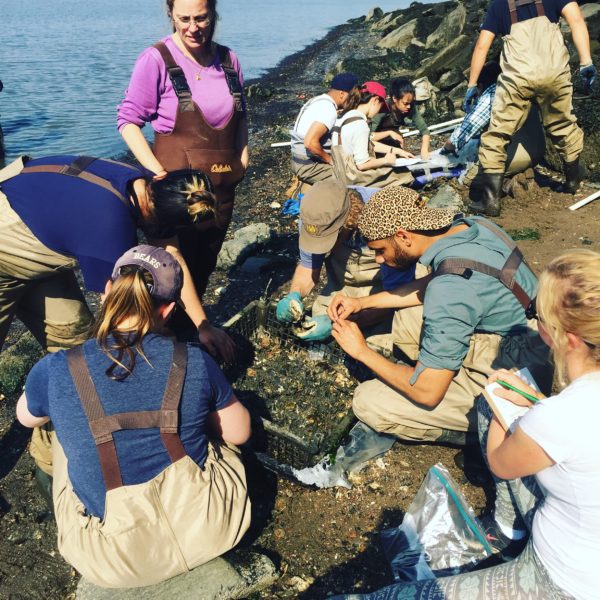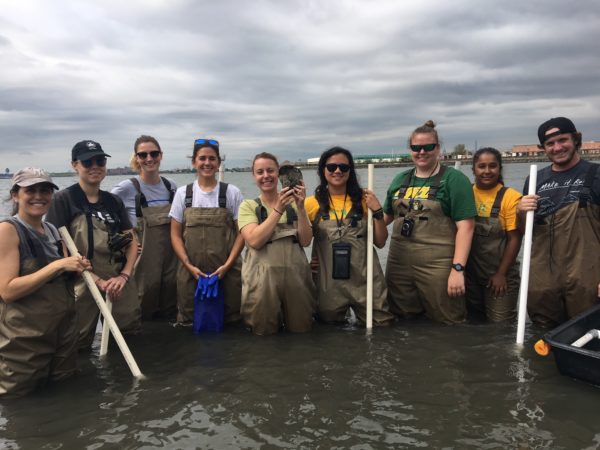NY/NJ Baykeeper Reports Increased Oyster Growth, Biodiversity at Bronx River Oyster Reef
June 13, 2019
NY/NJ Baykeeper and oysters are often synonymous, and for good reason. The Matawan-based nonprofit has been fighting for clean water and healthy habitats throughout the NY-NJ Harbor region for three decades, and it’s no secret that the mighty oyster can filter up to 50 gallons of water a day and create habitat for a diverse array of marine animals.
Since 2013, Baykeeper has maintained and monitored a one-acre community oyster reef in the Bronx River in the South Bronx, and the benefits of the reef are evident, according to Dr. Allison Fitzgerald, New York Oyster Program Coordinator at NY/NJ Baykeeper.
“There are multiple CSOs (Combined Sewer Overflow) along the lower Bronx River, and during strong storms when these CSOs put excess water into the river, the suspended sediment and fecal coliform bacteria can get to dangerous levels near the reef,” said Fitzgerald. “We have seen a decrease in sediment in the water column near the reef, indicating that the oysters are helping to remove sediment from the water.”
Fitzgerald, who noted that reducing sediment is an important aspect of cleaner water, also cited increased biodiversity at the reef.
“We found some of the baskets coated in a thick layer of mud, but underneath were some happy and alive oysters,” she said. “The mud was packed with clam worms, amphipods, and mud crabs, showing that the diversity on an oyster reef isn’t just due to the oysters themselves but also due to the mud on the seafloor adjacent to the reef. The reef is increasing biodiversity in the area.”
The Soundview Park community oyster reef was established for “ecological restoration”—the many benefits the reef provides for the rest of the NY-NJ Harbor Estuary.

Although New York City once boasted the largest oyster reefs around New York City, oysters are now functionally extinct in the region. According to Fitzgerald, adding small experimental plots such as the Soundview Park reef across the City will allow Baykeeper and other groups to bring back the filtering function and habitat complexity reefs offer, along with the shoreline protection it provides.
Situated at the confluence of the Bronx and East rivers across the water from LaGuardia Airport and Hunt’s Point shipping terminal, the Soundview Park oyster reef is made from bagged shells, with several oyster-monitoring baskets placed atop the reef in order to measure and count the oysters and animals living there.
“The shells of baby oysters—also known as spat–stick to adults and grow up, literally, on the backs of their ancestors,” Fitzgerald said. “This creates a hard substrate, with intricate holes and crevices for fish, crabs and other invertebrates to swim through and use for food and shelter.”
Oysters at the reef site are naturally recruited through the wild oyster population that lives on the Soundview shoreline. Baykeeper regularly monitors the reef and oyster baskets during low tide.
“We have been lucky to see spat the past few summers,” said Fitzgerald. “This is a good sign. Over the past few years, we have seen an increase in species found, including more fish and crabs. We’ve also seen growth on the oysters, and the average length of oysters in our baskets is increasing yearly.”
During Baykeeper’s monitoring sessions, the oysters and other marine animals living on the reef are counted and measured. These include crabs and oyster drills, small amphipods and worms and fish, who use the reef for food and refuge.
Some of the oysters are later taken to the lab at New Jersey City University (NJCU), where Fitzgerald is an assistant professor in the Biology Department, to check them for gonad development—an indicator of whether they will spawn during the summer months. Throughout the summer, Baykeeper closely monitors for the appearance of spat on the adult oysters on the reef.
“The findings from the outstanding work of Dr. Fitzgerald and the Baykeeper Oyster restoration team in the Bronx River highlights the value of investing in our urban waterways and the communities that surround them,” said NY/NJ Baykeeper CEO Greg Remaud.
Fitzgerald said the monitoring team, which went out for its first 2019 monitoring session last month, has seen a big upswing in EcoVolunteer involvement at the reef.

“Each year we get more volunteers and citizen scientists out to the reef, and recruit more college and high school students to use our “living lab” to do some research projects over the summer,” she said. “Our volunteers are the reason behind the success of this program—the amount of work that is done on the reef could not happen without many hands helping,” she said. “They are extremely dedicated, getting up before dawn to help count oysters. I am very thankful for our enthusiastic team of volunteers.”
